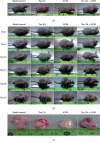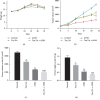The Synergistic Antitumor Effect of Tanshinone IIA Plus Adriamycin on Human Hepatocellular Carcinoma Xenograft in BALB/C Nude Mice and Their Influences on Cytochrome P450 CYP3A4 In Vivo
- PMID: 34189145
- PMCID: PMC8192217
- DOI: 10.1155/2020/6231751
The Synergistic Antitumor Effect of Tanshinone IIA Plus Adriamycin on Human Hepatocellular Carcinoma Xenograft in BALB/C Nude Mice and Their Influences on Cytochrome P450 CYP3A4 In Vivo
Abstract
Objective: Hepatocellular carcinoma is one of the most common diseases that seriously threaten human life and health. In this study, we evaluated the inhibitory effect of tanshinone IIA (Tan IIA) combined with adriamycin (ADM) on human hepatocellular carcinoma and developed a platform to assess the function if Chinese herbal ingredients combined with chemotherapy drugs have synergistic antitumor effects in vivo.
Methods: Established animal model of human hepatocarcinoma HepG2 cell in nude mice. Mice were divided into model control group, Tan IIA group, ADM group, and Tan IIA + ADM group. The changes from general condition, weight, tumor volume, and inhibition rate were observed. The data were gathered from serum AST level and histopathological changes. The content and activity of cytochrome P450 were determined by spectrophotometric analysis. CYP3A4 protein expression was analyzed by western blotting. The binding model crystal structure of Tan IIA and ADM with pregnane X receptor (PXR) was evaluated by Discovery Studio 2.1.
Results: A combination of Tan IIA with ADM could improve life quality by relieving ADM toxicity, decreasing tumor volume, declining serum AST level, and improving liner pathological section in tumor-bearing mice. The inhibitory rates of Tan IIA, ADM, and cotreatment were 32.77%, 60.96%, and 73.18%, respectively. The Tan IIA group significantly enhanced the content of cytochrome b5, P450, and erythromycin-N-demethylase activity. CYP3A4 protein expression was enhanced obviously by the Tan IIA + ADM group. Virtual molecular docking showed that both Tan IIA and ADM could be stably docked with the same binding site of PXR but different interactions.
Conclusions: Tan IIA in combination with ADM could improve the life quality in tumor-bearing mice and enhance the antitumor effect. The Tan IIA group increased the concentration of cytochrome P450 enzymes and activity. Combined Tan IIA with ADM could upregulate the CYP3A4 protein expression and make relevant interaction with protein PXR by virtual docking.
Copyright © 2020 Tao-Li Liu et al.
Conflict of interest statement
The authors declare that they have no conflicts of interest.
Figures








Similar articles
-
Tanshinone IIA ameliorates dextran sulfate sodium-induced inflammatory bowel disease via the pregnane X receptor.Drug Des Devel Ther. 2015 Dec 7;9:6343-62. doi: 10.2147/DDDT.S79388. eCollection 2015. Drug Des Devel Ther. 2015. PMID: 26674743 Free PMC article.
-
Tanshinone IIA exerts protective effects in a LCA-induced cholestatic liver model associated with participation of pregnane X receptor.J Ethnopharmacol. 2015 Apr 22;164:357-67. doi: 10.1016/j.jep.2015.01.047. Epub 2015 Feb 7. J Ethnopharmacol. 2015. PMID: 25660334
-
The antitumor effect of tanshinone IIA on anti-proliferation and decreasing VEGF/VEGFR2 expression on the human non-small cell lung cancer A549 cell line.Acta Pharm Sin B. 2015 Nov;5(6):554-63. doi: 10.1016/j.apsb.2015.07.008. Epub 2015 Sep 26. Acta Pharm Sin B. 2015. PMID: 26713270 Free PMC article.
-
Effects of salvianolic acid B and tanshinone IIA on the pharmacokinetics of losartan in rats by regulating the activities and expression of CYP3A4 and CYP2C9.J Ethnopharmacol. 2016 Mar 2;180:87-96. doi: 10.1016/j.jep.2016.01.021. Epub 2016 Jan 19. J Ethnopharmacol. 2016. PMID: 26806573
-
Tanshinone IIA: A Review of its Anticancer Effects.Front Pharmacol. 2021 Jan 14;11:611087. doi: 10.3389/fphar.2020.611087. eCollection 2020. Front Pharmacol. 2021. PMID: 33597880 Free PMC article. Review.
Cited by
-
Tanshinone IIA and hepatocellular carcinoma: A potential therapeutic drug.Front Oncol. 2023 Jan 31;13:1071415. doi: 10.3389/fonc.2023.1071415. eCollection 2023. Front Oncol. 2023. PMID: 36798821 Free PMC article. Review.
-
Salvia miltiorrhiza Bunge (Danshen) and Bioactive Compound Tanshinone IIA Alleviates Cisplatin-Induced Acute Kidney Injury Through Regulating PXR/NF-κB Signaling.Front Pharmacol. 2022 Mar 24;13:860383. doi: 10.3389/fphar.2022.860383. eCollection 2022. Front Pharmacol. 2022. PMID: 35401224 Free PMC article.
-
Frontier progress of the combination of modern medicine and traditional Chinese medicine in the treatment of hepatocellular carcinoma.Chin Med. 2022 Jul 30;17(1):90. doi: 10.1186/s13020-022-00645-0. Chin Med. 2022. PMID: 35907976 Free PMC article. Review.
References
LinkOut - more resources
Full Text Sources

